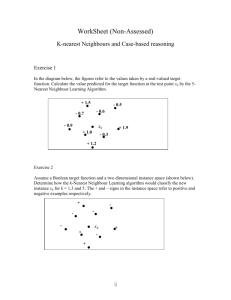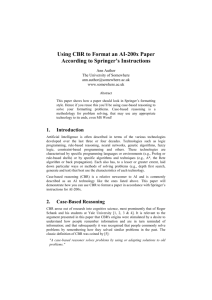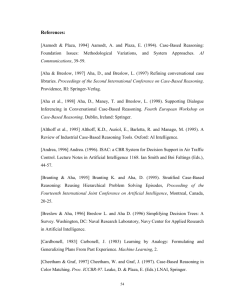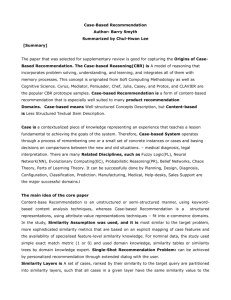A review of case-based learning practices in an online MBA program
advertisement
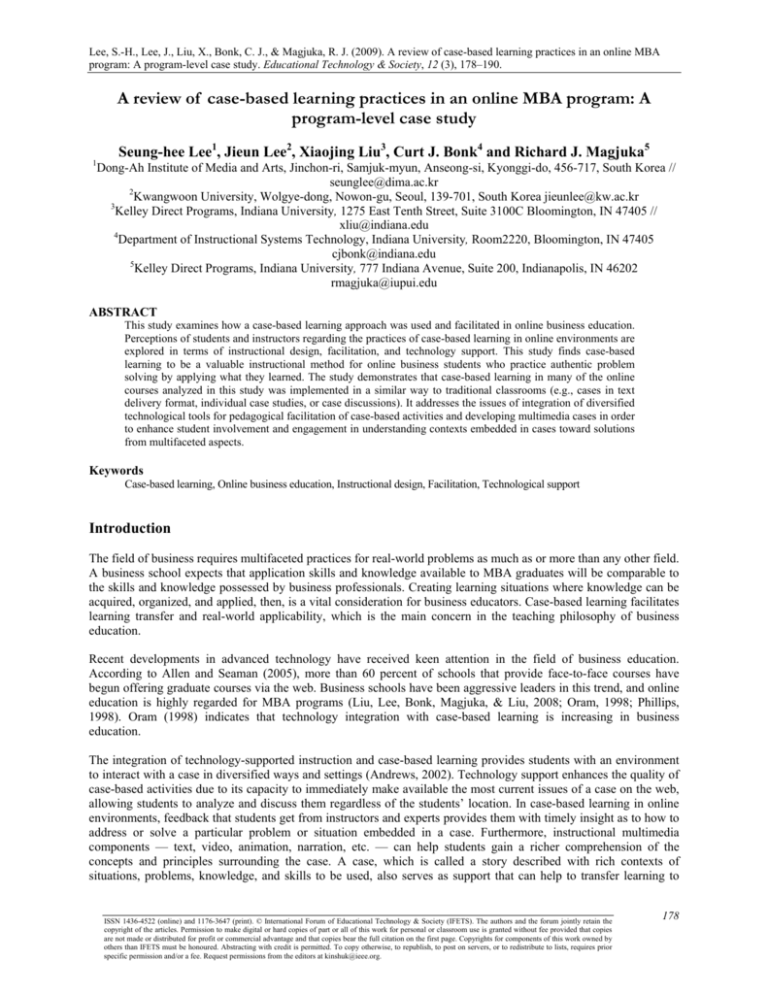
Lee, S.-H., Lee, J., Liu, X., Bonk, C. J., & Magjuka, R. J. (2009). A review of case-based learning practices in an online MBA program: A program-level case study. Educational Technology & Society, 12 (3), 178–190. A review of case-based learning practices in an online MBA program: A program-level case study Seung-hee Lee1, Jieun Lee2, Xiaojing Liu3, Curt J. Bonk4 and Richard J. Magjuka5 1 Dong-Ah Institute of Media and Arts, Jinchon-ri, Samjuk-myun, Anseong-si, Kyonggi-do, 456-717, South Korea // seunglee@dima.ac.kr 2 Kwangwoon University, Wolgye-dong, Nowon-gu, Seoul, 139-701, South Korea jieunlee@kw.ac.kr 3 Kelley Direct Programs, Indiana University, 1275 East Tenth Street, Suite 3100C Bloomington, IN 47405 // xliu@indiana.edu 4 Department of Instructional Systems Technology, Indiana University, Room2220, Bloomington, IN 47405 cjbonk@indiana.edu 5 Kelley Direct Programs, Indiana University, 777 Indiana Avenue, Suite 200, Indianapolis, IN 46202 rmagjuka@iupui.edu ABSTRACT This study examines how a case-based learning approach was used and facilitated in online business education. Perceptions of students and instructors regarding the practices of case-based learning in online environments are explored in terms of instructional design, facilitation, and technology support. This study finds case-based learning to be a valuable instructional method for online business students who practice authentic problem solving by applying what they learned. The study demonstrates that case-based learning in many of the online courses analyzed in this study was implemented in a similar way to traditional classrooms (e.g., cases in text delivery format, individual case studies, or case discussions). It addresses the issues of integration of diversified technological tools for pedagogical facilitation of case-based activities and developing multimedia cases in order to enhance student involvement and engagement in understanding contexts embedded in cases toward solutions from multifaceted aspects. Keywords Case-based learning, Online business education, Instructional design, Facilitation, Technological support Introduction The field of business requires multifaceted practices for real-world problems as much as or more than any other field. A business school expects that application skills and knowledge available to MBA graduates will be comparable to the skills and knowledge possessed by business professionals. Creating learning situations where knowledge can be acquired, organized, and applied, then, is a vital consideration for business educators. Case-based learning facilitates learning transfer and real-world applicability, which is the main concern in the teaching philosophy of business education. Recent developments in advanced technology have received keen attention in the field of business education. According to Allen and Seaman (2005), more than 60 percent of schools that provide face-to-face courses have begun offering graduate courses via the web. Business schools have been aggressive leaders in this trend, and online education is highly regarded for MBA programs (Liu, Lee, Bonk, Magjuka, & Liu, 2008; Oram, 1998; Phillips, 1998). Oram (1998) indicates that technology integration with case-based learning is increasing in business education. The integration of technology-supported instruction and case-based learning provides students with an environment to interact with a case in diversified ways and settings (Andrews, 2002). Technology support enhances the quality of case-based activities due to its capacity to immediately make available the most current issues of a case on the web, allowing students to analyze and discuss them regardless of the students’ location. In case-based learning in online environments, feedback that students get from instructors and experts provides them with timely insight as to how to address or solve a particular problem or situation embedded in a case. Furthermore, instructional multimedia components — text, video, animation, narration, etc. — can help students gain a richer comprehension of the concepts and principles surrounding the case. A case, which is called a story described with rich contexts of situations, problems, knowledge, and skills to be used, also serves as support that can help to transfer learning to ISSN 1436-4522 (online) and 1176-3647 (print). © International Forum of Educational Technology & Society (IFETS). The authors and the forum jointly retain the copyright of the articles. Permission to make digital or hard copies of part or all of this work for personal or classroom use is granted without fee provided that copies are not made or distributed for profit or commercial advantage and that copies bear the full citation on the first page. Copyrights for components of this work owned by others than IFETS must be honoured. Abstracting with credit is permitted. To copy otherwise, to republish, to post on servers, or to redistribute to lists, requires prior specific permission and/or a fee. Request permissions from the editors at kinshuk@ieee.org. 178 various job settings. In other words, teaching and learning via case studies is powerful and will undoubtedly become richer, more authentic, and more widely used in the coming decades. However, studies related to online learning, distance education, or other technology-supported instruction often focus on technology systems or tools, rather than on examining the underlying nature of the online environment (Bonk & Dennen, 1999). How cases can be used effectively in online environments is an area of inquiry that has not received sufficient attention from educators, considering the aforementioned plethora of instructional possibilities. It is true that there is little agreement about such fundamental issues as instructional design, facilitation for learner engagement, and technology support associated with case-based learning activities in online environments. As online programs in many educational fields — including business education — have experienced rapid growth in recent years, it is critical to examine the use of case-based learning in online environments and the obstacles and challenges that instructors and students face in their actual experiences. Purpose of study This study explores the perceptions of students and instructors about the current practices of case-based learning in a fast-growing online MBA program at a large state university in the Midwest. It addresses the following research questions: 1. What are students’ and instructors’ perceptions regarding instructional design to enhance case-based learning in online environments? 2. What are students’ and instructors’ perceptions regarding facilitation to enhance case-based learning in online environments? 3. What are students’ and instructors’ perceptions regarding technology support to enhance case-based learning in online environments? Literature review Case-based learning in business education Case-based learning has been extensively used in several areas of professional education such as law, medicine, clinical health, and business as an alternative to the traditional lecture as an instructional method (Artan, 2007; Garvey, O’Sullivan & Blake, 2000; Marcus, Taylor, & Ellis, 2004; Williams, 2004). This instructional method is prevalent for teaching and learning in a business school context in particular. Instructors use business cases as the foundation of their teaching across the curriculum (Magjuka, Liu, & Lee, 2006). Case-based learning is defined as a method that involves studying actual business situations — written as an in-depth presentation of a company, its market, and its strategic decisions — in order to improve a manager’s or a student’s problemsolving ability. Cases are typically used to investigate a contemporary issue in a real-life context. There are multiple issues to consider and many “correct” or viable alternatives to solve the case issues are presented (Helms, 2006, p. 68). This definition echoes the idea that case-based learning can help students prepare to deal with the real-world problems they will face when leaving an academic environment, and ultimately, to find success within a specific business organization or profession by using these previously learned skills and experiences. The key to case-based learning is to create cases for educational purposes and to facilitate activities associated with cases. Cases are like stories to read and explore interactively. Cases direct students toward contexts to discuss and debate issues dynamically. Williams (2004) summarizes the benefits of case use for teaching and learning, stating that it allows learners to apply theoretical knowledge to real school contexts reason critically about complex situations and recommend courses of actions develop self-knowledge and recognize own assumptions clarify personal beliefs about teaching compare and evaluate their own and others’ perspectives 179 develop the practice of reflection (p. 20) The practical application of skills and knowledge learned in a business school is a key consideration for MBA students as well as their instructors and program designers. As a result, graduate business education has relied upon case-based learning. Many business schools have adopted the case-based learning approach as a central teaching and learning method. The features of case-based learning (e.g., applicability, contexts, etc.) fulfill the educational objectives that MBA students pursue. Students are prompted to integrate their prior experiences to analyze cases and to explore solutions through discussion, reflection, and decision making (Wang & Bonk, 2001). Case studies allow students to develop their critical and analytical reasoning skills and problem-solving processes (Merseth, 1999). Cases that present real or hypothetical problems can prompt deep discussions, which assist students in developing solutions (Benbunan-Fich & Hiltz, 1999). Case-based learning in online environments While case-based learning challenges students by providing authentic experiences of business situations (Williams, 2004), case studies itself will not guarantee the efficacy of online learning processes because some effective pedagogical approaches that instructors use in their traditional classes may not be applicable for online environments. When case-based learning is implemented online, instructors should be aware that pedagogical activities can be either limited or fostered by conditions associated with technology tools employed. Technology can offer cognitive support for student thinking by reducing working memory limitations, and help students to represent evolving ideas, concepts, and solutions. At the same time, technology can burden students since they have to manage tasks and tool functions simultaneously in the learning processes. The review of prior studies on case-based learning in online environments implies that three aspects of online learning should be considered: (1) instructional design for case development and delivery; (2) facilitation for student engagement in online learning; and (3) technology support for effective case-based activities. From a perspective of instructional design, developing well-designed learning materials and activities is critical to effective teaching and learning. What types of cases are deemed more effective? Just how do instructors set up activities associated with cases? What degree of control do students have in different case formats and courses? It is said that cases highlight a variety of concepts and introduce an assortment of strategies. With cases, students interpret, analyze, inquire about ideas, and solve problems. Problem-centered cases, situations, and scenarios are used to examine and clarify the complexities of practices (Rourke & Anderson, 2002). As cognitive acts occur, students begin to move from the status of a novice and gain the perspective of a professional within the field. However, the study by Marcus, Taylor, and Ellis (2004) on an online case-based learning reported findings that some students reached only a superficial level of knowledge even in a contextually rich learning environment. The less satisfactory study results remind us of the fact that the implementation of this method in itself does not ensure satisfactory learning or improvement. Rather, it stresses the significance of the design of cases and appropriate facilitation to enable students to expose students to connections between theory and practice before they actually engage in real-world experiences. Another key to successful case-based learning is facilitation, which leads to student engagement. What determines student involvement in online learning activities? Williams (2004) points out that successful case-based learning requires instructors to employ questioning techniques and to moderate discussions through feedback and scaffolding. In online environments, dialogues and interactions are key components of a constructive environment wherein students build and negotiate their arguments and ultimately yield their final products. Action-oriented activities and discussions highlight the expanded roles and responsibilities of instructors, while often serving as the catalyst through which instructors can move from enacting the role of knowledge transmitter, to that of a learning guide or facilitator (Forman & Rymer, 1999). A necessary ingredient for facilitation is to apply pedagogical techniques that ensure student engagement in the construction of knowledge, anchor the case to prior knowledge, and expand and transform the knowledge to realworld situations (Harrington, 1995). Such techniques as questioning, feedback, scaffolding, or guidance also assist 180 students in activating their meta-cognition and exploring the implications of what they endorse with peer students and instructors. The degree to which available technology is employed impacts the effectiveness and efficiency of online activities. An excellent face-to-face case study method does not always work well when implemented through technological tools. Technological support is a critical component of conducting case-based learning in online environments, while technology is the major medium through which instructions, communication, and collaboration take place. In fact, the role of technology has been expanding in both face-to-face classrooms and online environments as it plays the role of a cognitive tool that supports the creation of meaning and knowledge sharing with peers and experts (Jonassen, Peck, & Wilson, 1999). Successful online learning must create circumstances under which instructors engage students in an ongoing discussion over a case, similar to faculty-led case discussions in the classroom. Serving this purpose, tools are encouraged to be developed in a way that allows students to generate conceptual linkages and debate key points, as well as allowing for counter-cases, expert commentary, and the display of chains of reasoning (Bonk, Hara, Dennen, Malikowski, & Supplee, 2000). Fortunately, recent advances in technology allow instructors to integrate a variety of such technological tools as asynchronous discussion forums, chat rooms, synchronous meeting tools, or multi-way conferencing (e.g., Microsoft NetMeeting, Macromedia Breeze) for the discussion and reflection of cases. Moreover, technology can support instructors in the development and presentation of cases. Since multimedia is deemed to increase the contextual understanding of a case, its use is suggested as a highly effective delivery device for cases. Cases presented with multimedia often contain an assortment of contextual facets that might be displayed through animation, video clips, text descriptions, and audio components. Of course, with all these options, presenting cases in the most compelling and efficient manner using multimedia formats is no easy task for instructors, as devising multimedia cases and converting text-based cases into different formats is demanding and time-consuming. Data collection This study adopted a case study to examine current practices of case-based learning in online environments. Yin (1994) defines case study as “empirical inquiry that investigates a contemporary phenomenon within its real-life context, especially when the boundaries between phenomenon and context are not clearly evident” (p. 13). An online MBA program at a business school of a large university in the United States’ Midwest was selected for this case study. This particular program was designed for business professionals who remained active in their current employment throughout their program. While the traditional MBA program still exists at the institution, this online MBA program was established in 1999 with an enrollment of approximately a dozen or so students and saw a rapid increase in students each year thereafter. In 2006 there were more than 1,000 students taking the programs and it is now recognized as a representative online business program in terms of enrollment and diversity of the courses offered to students. Course content was newly developed or converted from traditional classroom lectures to fit online environments, and managed in ANGEL, a course management system. Course activities such as communications, announcements, and discussions were conducted online, with the exception of one residential training week. Given the long history of the use of case-based instruction in both the traditional program and the online program, this study was designed to explore online case-based learning experiences from both student and instructor perspectives. Data collected in this study included course analyses, surveys of students, and interviews with and focus groups of instructors and students. Course analyses The purpose of course analysis in this study was to objectively analyze the patterns of usage of case-based learning in online courses. The present study devised an analysis framework to examine online course structure to identify how the courses utilized case-based learning in instruction. The framework consisted of several categories such as the use of technology, case delivery format, case activity, and collaboration. Twenty-seven online courses across a wide spectrum of business disciplines were selected for content analyses. The content of course websites — including student participation in course activities via asynchronous discussion boards, synchronous chat rooms, or shared workspaces — was analyzed to explore the instructional practices that had been employed in the online MBA courses. Two researchers independently conducted the course content analyses according to common themes. 181 Descriptive data were obtained by counting the number of occurrences based on the coding scheme. The inter-coder agreement was 81 percent, and the data coding was considered reliable. Surveys The survey was used to investigate student perceptions of the actual application and usefulness of case-based learning in online environments at a program level. While the content analysis coding scheme was used to analyze course design and activity structures from an objective standpoint, the survey was designed to gauge students’ perceptions and attitudes regarding various aspects of online learning. The instrument contained Likert-type questions with a five-point scale (indicating 1 = strongly disagree, 5 = strongly agree) and open-ended questions. One hundred and nine second-year students who attended the first week of face-to-face gatherings in the year were invited to participate in the survey, and a total of 102 students responded to the online surveys. The detailed demographical student information revealed that 82 percent of the online MBA students were males, about 80 percent were between 26 to 40 years old, and 90 percent had taken more than seven online courses in the program. Each of the students had taken two to four different courses per quarter. The internal reliability of the survey, according to Cronbach’s alpha, was reported at .91, an acceptable figure. Interviews Interviews of 27 faculty members and 10 students were conducted in order to obtain an in-depth understanding of the operation of online instruction within this online MBA program and of the case-based learning activities that were incorporated into it. In detail, semi-structured questions included issues such as case selection (or development), interactions with students via case studies, and effectiveness of case-based activity. Each interview took 45–75 minutes and was taped, recorded, transcribed, and coded. Transcribed interviews were subsequently classified under such categories of case-based learning as instructional design, facilitation, technology support, and other issues. Findings The data were analyzed into several categories based on the literature review: instructional design, facilitation, and technology support, in addition to educational value and benefits of case-based learning. Values and benefits One of our research findings relates to the widely held perception that MBA students and instructors value a casebased learning approach in business education. According to the survey results, 86 percent of students pointed out that case-based learning is an important instructional method (M = 4.24, SD = .75). Here, students perceived that business cases bring practical examples of what the instructors try to teach, and that course content is highly valued when instructors include opportunities for case-based study. In terms of the benefits of a case-based learning method, about 87 percent of students pointed out that case-based learning fostered the application of newly learned concepts and skills into practices to develop critical thinking skills (M = 4.24, SD = .86). As one student noted: Case-based learning is definitely a better way because it forces you to think and for the other ones, like, for example, the courses that were just problematic problems and answers, right? So that’s very easy. If you read the textbook you can solve the problem and you don’t really have to think much because you’re not really thinking of how to apply the knowledge to something else. Instructional design Regarding students’ and instructors’ perceptions of the actual design of business cases and activities, the data were collected from student surveys and course analyses. According to the findings, students were satisfied with the presentation format of business cases used in their online courses (M = 4.00, SD = .80). 182 As a way of cross-checking student responses, the research investigated the process of case-based learning through instructor interviews. Online instructors were confident and comfortable implementing case teaching strategies in online environments since they had previously taught case-based activities in face-to-face courses. The interview analyses found that many instructors used the same case teaching materials for online instruction or slightly adapted them rather than creating entirely new materials. When they planned online case teaching, the primary aim was to create an online learning experience as similar as possible to what students had experienced in face-to-face classes. As one instructor emphasized, “(I am)…trying to make it as close to the experience that we had in class as possible, with a couple of changes.” In terms of case selection, most instructors demonstrated considerations of how selections would cater to the nature of online learning environments. Instructors tried to select cases based on originality and real-world relevancy. They tried to update case selections to avoid re-using cases across semesters, which could lead to plagiarism in an online environment. For example, one instructor commented: If you use public sources from very popular textbooks, there’s a lot of material out there that people can get their hands on and it’s hard to change that every semester. But in my course, these case studies are very original and I change them every semester, so it makes it harder to cheat. It makes it harder on me because I can’t keep using the same materials all the time. In terms of case design and presentation formats, the content analyses of 27 courses revealed variations in the formats for case-based learning used in courses, depending upon the nature of specific courses and instructional purposes. For instance, cases in text delivery formats such as textbooks or text material packages were a widely used format for delivering business cases (10 courses, 37 percent). The findings reported that five courses (19 percent) employed simulations and games as a way of enriching contexts within case studies, whereas audio or video clips were utilized in only two courses (7 percent). Activity options that provide students with an opportunity to generate cases on their own were in relatively low use (7 percent). Students showed mixed attitudes toward the used of text-based cases in online courses. Some students preferred more multimedia presentations of cases that effectively convey real-world business situations while others appreciated the efficiency of text-based case presentations. For example, two students mentioned the following: I like the text based [cases]… I can see how they’re setting it up and where it’s going to go. I would just like to see the business if possible because this will be just like our daily work…this [case] can be delivered the same way like live video or using the lab or whatever instead of using just plain text, that’s too primitive. Facilitation One of the reported concerns related to case-based learning in online environments was that students often struggle to understand how to deal with a lack of instruction (this also applies in face-to-face classrooms). This study investigated how case-based learning was coordinated and facilitated by instructors in online environments. The findings suggest how instructors facilitate case-based learning in online environments. First of all, many instructors responded that they experienced a change in their role, and they emphasized the coach or mentor role when teaching with cases online. In effect, it was possible in online environments to monitor and support student learning with the aid of technology while, in traditional settings, in contrast, coaching was too often constrained by available time (Wang & Bonk, 2001). Guiding conceptual understanding and providing mentoring during discussion activities rather than just lecturing was more prevalent in online environments. As seen in the following quote from an instructor, encouraging discussions among students was emphasized rather than direct instruction or lectures, as often occur in face-to-face classrooms: … They [students] associate the success of a course with how good the professor is on the platform… So coaching sounds more like what you do online… [Meanwhile] lecturing is what you do in the regular classroom. In examining the level of interactions in online case-based learning, class discussions, self case studies, individual write-ups, role playing, and team projects stood out as the more predominant case activities employed. The findings 183 indicate that whole-class discussion (18 courses, 67 percent) was the most popular instructional activity with cases. On the other hand, in some courses students explored given cases individually (16 courses, 59 percent) and conducted case studies in collaborative teams (11 courses, 41 percent). The level of student engagement in groupdiscussions was varied, and about 15 percent of students on average were ranked as leading participants for those activities. Moreover, managing feedback and arguments was considered another key element in the effective facilitation of online case-based learning. With whole-group discussions and team activities, peer feedback was considered critical to encourage group work. In 16 courses, students were reported to share frequent peer feedback (59 percent). Students pointed out that peer comments and advice were highly appreciated with respect to in-depth understanding. In 15 courses (56 percent), arguments and debates were encouraged with business cases. Arguments from different perspectives were also a benefit of online case-based learning. However, student choice or options for selecting different cases for discussion was relatively low (22 percent). However, there was a limitation in exchanging feedback and comments online due to the use of asynchronous textbased communications for case analyses. Students sometimes experienced difficulty typing in their ideas fully, especially as compared to oral communications, and this obstacle often resulted in superficial discussions as shown in the remark below. There is a little bit of difference because you have to give your feedback, the student has to give their feedback to the case online, therefore you have to type it, therefore you may be able to not type as much as you would ordinarily say and then if you type a response to a case-based question you may not get an answer to that response, therefore you may not have the ability to further the discussion. Where the message traffic may only go one or two ways, that’s it; whereas if it’s a faceto-face setting you may be able to say something, I’ll say something back, you would say something again, and you have that exchange going on where that’s definitely a limitation of the Internet. To verify the content analyses results, student perceptions on facilitation issues were reviewed in this study. The results indicated that the level and quality of instructors’ facilitation of online case-based learning was positively perceived by students. Eighty-eight percent of students responded that they were satisfied with the various interactive activities (e.g., class discussions, individual explorations, team activities, etc.) that had been designed for case studies in their online MBA courses (M = 4.12, SD = .69). Table 1. Summary of student perceptions of case-based learning Item Percentage Case-based learning is a critical teaching and learning technique in online courses. Activities designed for case-based learning are helpful in deepening my learning. Mean (std.) 86% 4.24 (0.75) 88% 4.12 (0.69) Case-based learning experiences are critical to enhance real-world knowledge and skills. 77% 4.24 (0.86) Technologies in online courses are effective in supporting case-based learning. 79% 3.84 (0.75) Case-based learning is facilitated in ways to support knowledge67% building. (Percentage indicates the portion of student responses marked “agree” and “strongly agree.”) 3.74 (0.79) Technology support In terms of integrating technology into pedagogy, about 79 percent of students were relatively positive about technology integration in supporting case-based learning in their online courses (M = 3.84, SD = .75). The survey and interview findings show that students and instructors expected to use more advanced technologies that might more efficiently engage the students in case-based learning activities. 184 An asynchronous discussion forum was still a core technological tool. Throughout the discussion forums, students brainstormed, exchanged, and elaborated on ideas that might solve a particular case situation. As alluded to previously, a common practice with discussion forums was to assign a case text for students to read before discussions and then discuss the questions posted by the instructor. More significantly, from the course analysis, this study found that the program developed and implemented a set of proprietary pedagogical tools designed to address online case-based learning to be as effective as that of traditional classrooms. The technical functions of ordinary discussion forums were customized to ensure case-based learning activities in different ways for different instructional purposes. In the program, there were four different types of asynchronous discussion forums (the Q & A forum, round robin forum, simple forum, and role-based forum). The previous study (Magjuka et al., 2006) explained that the main function of the Q & A forum was that students were unable to read any posts of their peers until they posted their own opinions on asynchronous discussion boards. This function allowed students to have enough time to articulate their thinking clearly. From a pedagogical perspective, this function assisted students in reflecting their learning process and building knowledge. On the other hand, the round robin forum enabled students to deal with a series of cases, and accordingly they learned how to solve problems in a sophisticated context. Also, a business law faculty member used the role-based forum to designate the roles of judge, plaintiff, and defendant, and each party placed arguments in a simulated court forum. Instructors combined forums and then strung them together over time to structure a business case analysis online for their learning goals and aspirations. The interview results of instructors and students supported different types of discussion forums that assisted in different instructional intentions. Despite these positive findings, there remained much room for technical improvement to more effectively support online case-based learning. Instructors raised the issues of attributes of asynchronous tools such as the lack of social presence, absence of emotional cues, and high potential for misinterpretation. As shown in the quote below, one instructor noted the importance of accuracy and clarity when using online cases due to a lack of visual cues in online conversations and limited forms of instructional guidance: The level of precision that you need in the online world is probably five or six times the level of precision that you need in the classroom, because, again, [in the classroom] you have visual cues to tell you yes or no. People, they either understand or don’t understand; whereas you have to be going through much more specific detail, not even sure that they’re understanding, but at least you’ve made the attempt to reduce any ambiguity. It was reported that the limited capability of online technologies constrained the degree of interactive collaborations and communications in the process of case-based learning activities. Some students recognized the benefits of synchronicity via a text-based chat tool or real-time conferencing tool, which allowed them to ponder the cases and transfer their thoughts into text in real time, as shown by the following quote: That’s the only thing that really is difficult about some types of cases is how you discuss something that you would normally draw or diagram like when you’re, you know, trying to motivate people to think in the same direction you are…it’s great to have that face-to-face interaction because I notice it’s a lot smoother when we’re here in this in-residence than it is online. Discussion The findings of this study claim that the case-based learning approach can be as effective in online environments as in traditional face-to-face classroom settings. It reflects positive student perceptions on the practices of case-based learning in online environments. The study results imply that students learn effectively as long as online case-based learning activities are carefully designed and managed. How can we design and implement case-based learning activities successfully, considering the nature of online environments? Based on the study results, we can explore issues fundamental to the implementation of successful case-based learning in online environments. Maximizing the use of asynchronous technological tools for case-based activities Case-based learning comprises a student-oriented instructional approach. It is important to create an environment in which students can naturally engage in case discussions and analyze and reflect in the midst of learning processes 185 without pedagogical and technical barriers. The present study shows the pattern of use of technology in case-based learning in online environments. Specifically, the representative MBA program maximized attributes of asynchronous discussion forums to meet instructional goals. The study found that instructors of the program designed a variety of pedagogical activities such as questioning, debates, and role-playing to enhance case-based learning. A set of discussion forums was designed to address these activities in an online environment to ensure the effectiveness of online learning at the same level of traditional classrooms. For instance, the role-based forum also is the place where a student can take an active role in case discussions or debates relevant to a particular topic. Role play provides an authentic learning environment where learning is situated in real-world contexts (Herrington & Oliver, 2000). With the role-based forum, students experience conflicts and confrontations similar to those which they could face in the real business world. Throughout this activity, students become familiar with how to lead arguments, make decisions, and negotiate with others for better solutions. When appropriately integrated into instructional purposes, case-based learning in online environments is as effective as it is in traditional classrooms. Providing feedback to facilitate case-based learning activities In the present study, we found that online instructors had actively monitored and facilitated the process of sharing multiple viewpoints and negotiating ideas during case activities through diversified instructional activities. As a result, the students reported positive learning experiences, implying that the processes of monitoring and facilitation are critical variables for determining the quality of case-based learning experiences, and instructors should transform their role to guide or facilitators from that of lecturer. This finding reflects Artan’s (2007) study that interactions and quality of discussions can be influenced by instructors’ intentions and facilitating skills. Further, course effectiveness improves when instructors design and facilitate case-based activities as a way to provide chances for students to reflect on their learning processes as well as on course content, as Marcus and his associates (2004) recommend. According to the findings, peer feedback and advice were appreciated for building in-depth understanding. This result indicates that feedback from instructors and classmates is an important element that comprises successful online facilitation and promotes student learning processes. Benbunan-Fich and Hiltz (1999) reported that delayed feedback caused students to complain about the online learning process. Obviously, students in online environments have to spend more time and effort to coordinate work and combine different opinions into final products. The study claims that a critical element of successful instruction is that instructors lead students to be incisive and thorough in their case analyses by providing appropriate scaffolding to assist students in solving problems (Fitzgerald, Hollingsead, Miller, Koury, Mitchem, & Tsai, 2007). The findings indicate that the visibility of the instructor and students in the process of case activities can trigger high satisfaction with online learning. Designing collaborative discussions to enhance case-based learning Traditionally, case-based learning has been conducted individually by having students read problem-based scenarios to prepare for action plans and work toward solutions (Rourke & Anderson, 2002). However, the nature of casebased learning does not seek a single solution or answer to problems. It does not emphasize one correct answer; rather, it puts more weight on the process by which solutions are reached through analysis, discussion, and decisionmaking. An online learning environment encourages the process of developing solutions since learning experiences are constructed by conversing, synthesizing ideas, and reflecting on issues related to the presented case. Accordingly group discussions and collaboration are the most important parts of online case-based learning (Rourke & Anderson, 2002). Not surprisingly, this study also found that individual case analyses and case essays were frequently used. The process of individual studies helps students to develop opinions on their own and to utilize personal experiences and resources for solutions. In addition to individual case studies, the findings show that collaborative work on case discussions or analyses was used extensively in most courses of this program, suggesting that technology-mediated environments might provide students with better conditions of building co-knowledge and reflection through the access of the conversations in discussion boards. Accordingly, a collaborative case-based learning approach might better fit online environments. 186 From an instructional design perspective, attention is brought to empirical studies, which report mixed results for case-based learning in groups. Lee’s (2007) study shows that collaborative case-based learning conditions as well as traditional individual case study conditions led to improve student critical thinking. In other studies, group-based case–based learning activities in an asynchronous learning environment reach less satisfaction with the interaction process, although students produce better solutions to cases (Benbunan-Fich & Hiltz, 1999). This finding indicates that a group case-based learning activity can yield improved learning experiences for students to develop higherorder thinking, and produce more sophisticated solutions through discussions and negotiations (Salomon & Globerson, 1989), but it should be carefully designed and facilitated. For instance, as Flynn and Klein (2001) note, small group discussions can bring out better learning performance on case studies when arranged along with thorough individual preparation. Diversifying technology to support case-based learning Appropriate technical support and application is a crucial variable since it mediates and supports all activities and dialogues that occur in course management systems. The appropriate selection of technology and technical assistance can be a key factor in the success of online teaching and learning. In general, the study found that online instructors are skillful in integrating common course management tools such as asynchronous discussion forums in case-based learning. Although advanced technology tools are emerging in the educational field, asynchronous discussion forums were easy and favorable communication and collaboration tools for conducting case-based learning. The study also found that instructors used various types of discussion forums to meet their instructional purposes. On the other hand, students indicate a significant desire for more interactive tools such as synchronous conferencing tools or white boards to facilitate live presentations or immediate feedback. Although these tools have been available free of charge for quite some time, few instructors took advantage of them. This is due to a lack of awareness of the existence of such tools or skills in using them. Further training on technology use is needed to further enhance an interactive case learning experience. Interestingly, a previous study (Bonk, Hansen, Grabner, Lazar, & Mirabelli, 1998) reports that the attributes of asynchronous discussions (e.g., time delay) can prompt richer interactions and more diversity in the discussions than synchronous chatting or conference tools. This statement implies that the balanced use of asynchronous and synchronous tools is a necessity with instructional design of case learning activities rather than heavily relying upon a particular technological tool. As Rourke and Anderson (2002) reveal, instructors should maximize the unique attributes of each tool when integrating for educational purposes; for instance, emails are useful for meeting set-up and document sharing, discussion forums for idea exchange and development, and chatting or synchronous tools for brainstorming and decision making in the process of case-based learning. Utilizing technological attributes to create richer contexts in cases Designing activities with interesting and pedagogically sound cases that closely relate to course topics in real-world contexts is important for student online learning engagement. This study found business education experiencing a shift of its instructional circumstances from face-to-face classrooms to online environments. In this transformation, it was easily seen that the case-based learning approach was adapted in online environments, while teaching and learning materials were used in traditional formats for online environments. For instance, this study reports the wide practices of simply presenting cases in text version much the same as cases being read in textbooks in traditional classes (e.g., case scenarios in textbook package, text-based case materials, etc.). However, a written format might restrict comprehensive understanding of case situations, and presentation through multimedia elements provides a viable alternative that can increase contextual clues in cases. Also, this study found strong tendencies for instructors to progressively integrate multimedia as a means of delivering cases in online courses, although audio/video cases and cases in multimedia were in relatively low use. Instructors often scatter instructional materials and resources that need to be integrated in a more streamlined way. As an extended step to support the use of more enriched case presentations, providing instructors and students with appropriate technology support is needed. As Orngreen (2004) points out, technical support for case development by instructors helps instructors smoothly coordinate online activities. The increase of studies on the development and 187 implementation of multimedia cases in educational fields is a promising sign to that end. Well-developed multimedia cases can help students to process and restore information in many ways, which triggers deep learning transfer. In advocating the development of multimedia cases it is important to acknowledge the extra time and effort required in adopting them, in comparison to cases in text delivery formats, and the implementation of support tools has become the focus of much research. In the local context, the study found that the analyzed online MBA program had been developing an authoring tool for case-based learning titled the “Case Builder Tool,” which is similar to CaseMaker (Orngreen, 2004), designed as a supporting tool for instructors to develop and present business cases online. With Case Builder Tool, instructors could deliver cases with various multimedia elements. For example, instructors could add different components such as text, image, audio, video, and flash. Such supporting tools can help instructors to better organize their ideas to present case materials in more effective ways, while students obtain support for their individual and collaborative case analyses. Also, advanced multi-directional communication tools such as Macromedia Breeze and NetMeeting,feature desktop sharing with video and audio communications. These systems are expected to provide students with an ideal workspace to synergistically discuss cases and elaborate on solutions beyond the constraints of time and specific locations. In summary, a key educational challenge of online courses and programs is how to develop pedagogically effective technologically mediated environments that enhance the quality of education (Benbunan-Fich & Hiltz, 1999). This study examined the actual implementation of case-based learning in an online business education. The results of the ongoing study provide implications for online instructors and designers around the globe who plan to implement case-based learning in professional development courses and programs within higher education. Clearly, those in other professional schools (e.g., law, education, business, engineering, and medicine, etc.) will be interested in how to effectively embed the strategies of case-based learning in their online courses. The key results can be highlighted as follows: Case-based learning is a method widely used in online business education as well as in traditional classroom settings. Students and instructors perceived that case-based learning is a favorable method for online environments to foster application of newly learned knowledge into practice. Facilitation and timing feedback are key pedagogical techniques to enhance case-based learning in online environments. Whole case discussions and group discussions are widely used in online environments. Asynchronous discussion forums still play a key role in case discussions, although newly advanced technology is also available. Technology tools customized to meet educational purposes and learning activities enhance the quality of online learning activities Cases in text formats are still the most widely used means of case-based learning even in online learning environments. Diversifying case delivery formats is a way to create richer contexts, and multimedia cases can be one of the options. It is recommended that online instructors, instructional designers, and support staff acknowledge that the success of online business courses depends not on merely introducing advanced technology tools or systems by themselves but also on integrating appropriate uses of pedagogy in business contexts. This study suggests that instructors and students need to have more guidance both pedagogically and technologically to make a successful transition to online learning environments. In the end, this study provides a starting point for understanding the status of casebased learning in an online MBA program. Recommendations and limitations Although case-based learning is already a widely used method in business schools, how to best utilize online technology in case-based learning is an issue that must continue to be addressed by educators and researchers. While there is a substantial body of research related to case-based learning in online environments, few research efforts have specifically established guidelines, caveats, and other knowledge deemed vital for building and designing casebased learning in online environments. 188 This study examined the current practices of case-based learning in online business education from three aspects: (1) instructional design, (2) facilitation, and (3) technology support. It reconfirms the positive roles of case-based learning in online business education. This study demonstrates that under authentic learning environments in which learning is situated in real business contexts, case-based learning is a core pedagogical method to create extensive applications of knowledge and skills across all business disciplines. To bring out extensive learning transfer through online case-based learning, a creative design of instructional activities and comprehensive facilitation is critical (Garvey et al., 2000). There are several recommendations and limitations for better designing case-based learning activities. First, there is a need to provide detailed instructional guidelines regarding how to support student learning over the course of working with a case. Students who have never experienced case-based learning before can feel uncertain about the specific skills and knowledge they are supposed to acquire and how they are supposed to learn; ultimately, they often feel frustrated. Further, case-based learning in online environments can be a burden to conduct for students who are accustomed to instructor-oriented lectures in classroom settings. Students should be familiar with case-based learning procedures and functions of technological tools that are used for online learning activities. Accordingly, detailed instruction and elaborated coordination of case-based activities can assist in reducing ambiguity and confusion in learning processes. Second, effective instruction provides students with opportunities for planning and monitoring their learning journeys. It is beneficial for students to reflect on the contents and processes of their activities while facing the challenge of solving cases (Marcus, Taylor, & Ellis, 2004). Reflection can assist students in making decisions based on constantly changing sources of information. Instructors can guide student activities by offering questions that trigger deeper thought about cases and providing students with comments that can stimulate reflection. Third, effective case analyses are followed by the synthesis of learned concepts and knowledge. Relative learning resources and supplemental information are essential to enrich students in their practices of analyzing, filtering, and integrating information to develop solutions. For instance, hyperlinks and information embedded in the learning management system or posted on the web are highly useful to expand students’ learning experiences. Despite its helpful implications, this study has its own limitations. As a case study, the participants were limited to one online MBA program, and only a small sample of participants participated in the interviews. As a result, caution should be exercised when making generalizations of the findings presented here and projecting them onto other online programs or disciplines. However, this examination is expected to expand the lessons learned, with implications for those who hope to introduce case-based learning methods into the curriculum for their online business programs, despite the fact that the present study focuses on one representative online MBA program. In summary, it is expected that the findings and recommendations raised in this study provide highly valuable information and insight to assist online educators in designing successful and engaging case-based online learning experiences. This study did not address the impact of case-based learning on actual learning outcomes or performance in online environments. The follow-up study needs to investigate learning improvement in comparing several conditions: traditional case-based learning versus online case-based learning, or individual case-based learning versus collaborative case-based learning. References Allen. I. E. & Seaman, J. (2005). Growing by degrees: Online education in the United States, 2005. The Sloan-C Report. Retrieved November 28, 2006, from http://www.sloan-c.org/resources/growing_by_degrees.pdf. Andrews L. (2002). Preparing general education pre-service teachers for inclusion: Web-enhanced case-based instruction. Journal of Special Education Technology, 17(3), 27–35. Artan, A. E. (2007). Case-based discussions in an educational psychology course: Problem solving processes and interactions. Unpublished doctoral dissertation, University of Pittsburgh, USA. Benbunan-Fich, R., & Hiltz, S. R. (1999). Educational applications of CMCS: Solving case studies through asynchronous learning networks. Journal of Computer-Mediated Communication, 4(3), March. Retrieved November 28, 2005, from http://jcmc.indiana.edu/vol4/issue3/benbunan-fich.html. 189 Bonk, C. J., & Dennen, V. (1999). Teaching on the Web: With a little help from my pedagogical friends. Journal of Computing in Higher Education, 11(1), 3–28. Bonk, C. J., Hansen, E. J., Grabner, M. M., Lazar, S., & Mirabelli, C. (1998). Time to “connect:” Synchronous and asynchronous case-based dialogue among preservice teachers. In C. J. Bonk, & K. S. King (Eds.), Electronic collaborators: Learner-centered technologies for literacy, apprenticeship, and discourse (pp. 289–314). Mahwah, NJ: Erlbaum. Bonk, C. J., Hara, N., Dennen, V., Malikowski, S., & Supplee, L. (2000). We’re in TITLE to dream: Envisioning a community of practice, “The Intraplanetary Teacher Learning Exchange.” CyberPsychology and Behavior, 3(1), 25–39. Fitzgerald, G., Hollingsead, C., Miller, K., Koury, K., Mitchem, K., & Tsai, H. (2007). Case-based instruction through technology: Does implementation affect outcomes? Paper presented at AERA Annual Meeting, Chicago, IL. Flynn, A., E., & Klein, J. D. (2001). The influence of discussion groups in a case-based learning environment. Educational Technology Research and Development, 49(3), 71–86. Forman, J., & Rymer, J. (1999). The genre system of the Harvard case method. Journal of Business and Technical Communication, 13(4), 373–400. Garvey, M. T., O’Sullivan, M., & Blake, M. (2000). Multidisciplinary case-based learning for undergraduate students, European Journal of Dental Education, 4(4), 165–168. Helms, M. M. (2006). Case method of analysis. In M. M. Helms (Ed.), Encyclopedia of management (pp. 67–69). Farmington Hills, MI: Gale Cengage. Harrington, H. L. (1995). Fostering reasoned decisions: Case-based pedagogy and the professional development of teachers. Teaching and Teacher Education, 11(3), 203–214. Herrington, J., & Oliver, R. (2000). An instructional design framework for authentic learning environments. Educational Technology Research and Development, 48(3), 23–48. Jonassen, D. H., Peck, K. L., & Wilson, B. G. (1999). Learning with technology: A constructivist perspective. Upper Saddle River, NJ: Prentice Hall. Lee, K. (2007). Online collaborative case study learning. Journal of College Reading and Learning, 37(2), 82–100. Liu, X., Lee, S., Bonk, C., Magjuka, R., & Liu, S. (2008). Technology use in an online MBA program: Issues, trends, and opportunities. In T. Kidd & H. Song (Eds.), Handbook of research on instructional systems and technology (pp. 613–629). Hershey, PA: IGI Global. Magjuka, R., Liu, X., & Lee, S. (2006). Kelley Direct (KD) Toolkit: Toward the development of innovative pedagogical tools for business education. i-Managers’ Journal of Educational Technology, 3(2), 26–32. Marcus, G., Taylor, R., & Ellis, R. A. (2004). Implications for the design of online case based learning activities based on the student blended learning experience. In R. Atkinson, C. McBeath, D. Jonas-Dwyer, & R. Phillips (Eds.), Beyond the comfort zone: Proceedings of the 21st ASCILITE Conference (pp. 557–586). Perth, Western Australia. Merseth, K. K. (1999). A rationale for case-based pedagogy in teacher education [foreword]. In M. A. Lundeberg, B. B. Levin, & H. L. Harrington (Eds.), Who learns what from cases and how? The research base for teaching and learning with cases (pp. ixxv). Mahwah, NJ: Lawrence Erlbaum. Oram, I. (1998). Computer support of collaborative case based learning by MBA students. Unpublished doctoral dissertation, The Open University of Institute of Educational Technology, United Kingdom. Orngreen, R. (2004). CaseMaker: An environment for case-based e-learning. Electronic Journal of e-Learning, 2(1), 167–180. Retrieved April 10, 2006, from http://www.ejel.org/volume-2/vol2-issue1/issue1-art7-orngreen.pdf Phillips, V. (1998). Online universities teach knowledge beyond the books. HR Magazine, 43(8), 120–126. Rourke, L., & Anderson, T. (2002). Using web-based, group communication systems to support case study learning at a distance. International Review of Research in Open and Distance Learning, 3(2), 1–13. Salomon, G., & Globerson, T. (1989). When teams do not function the way they ought to. International Journal of Educational Research, 13(1), 89–100. Wang, F. K., & Bonk, C. J. (2001). A design framework for electronic cognitive apprenticeship. Journal of Asynchronous Learning Networks, 5(2), 131–151. Williams, M. (2004). Exploring the effects of a multimedia case-based learning environment in pre-service science teacher education in Jamaica. Unpublished doctoral dissertation, University of Twente, The Netherlands. Yin, R. (1994). Case study research: Design and methods. Beverly Hills, CA: Sage Publications. 190

